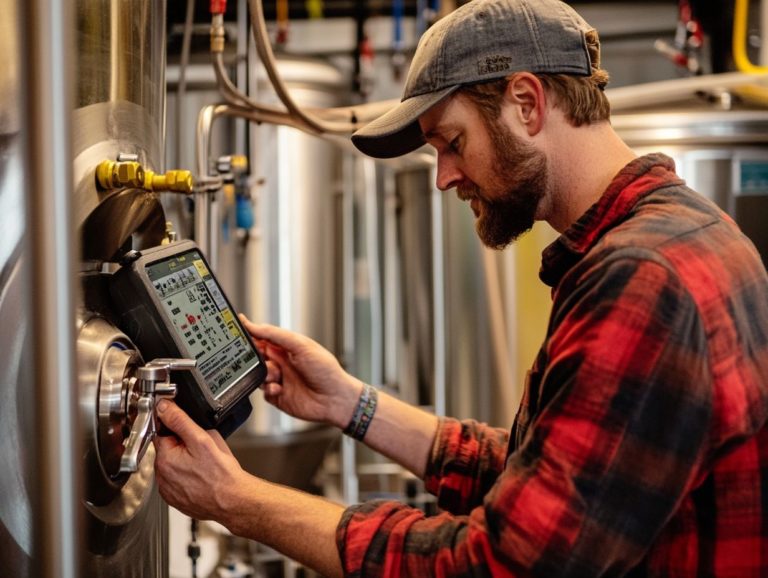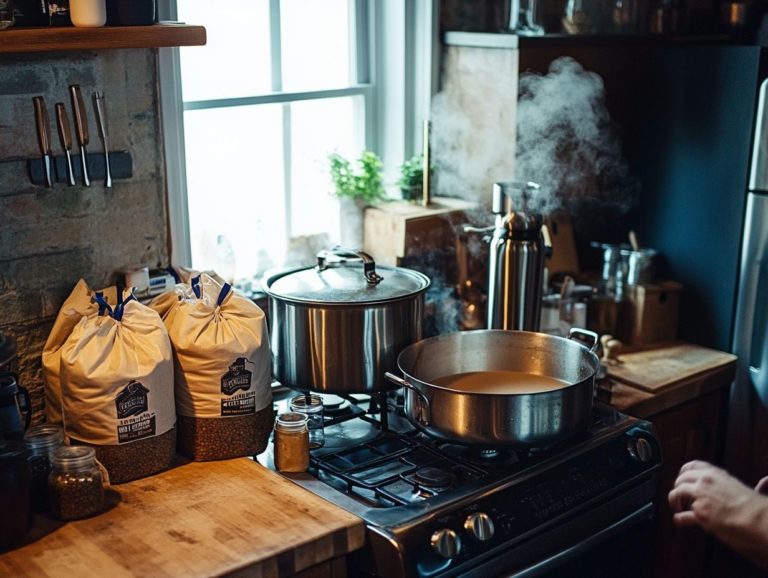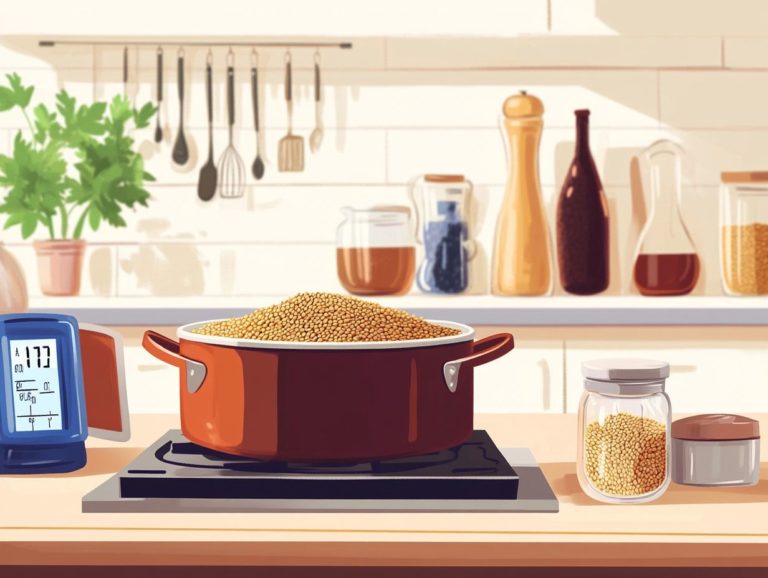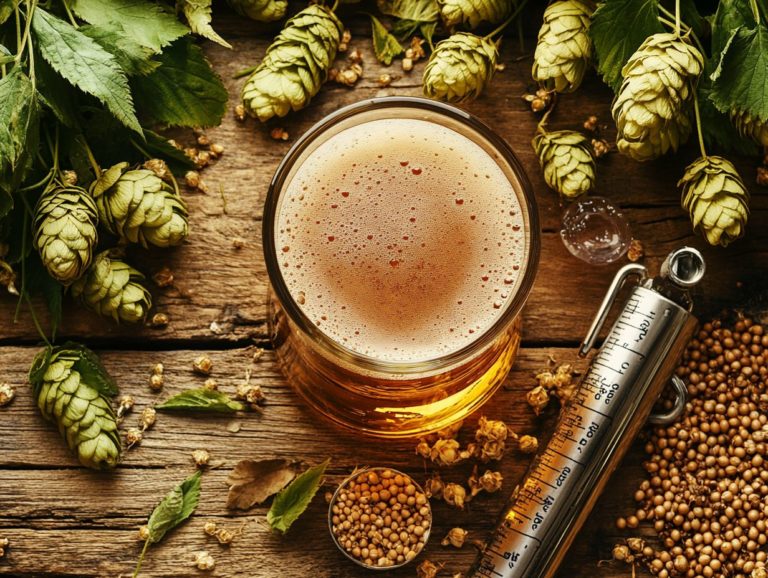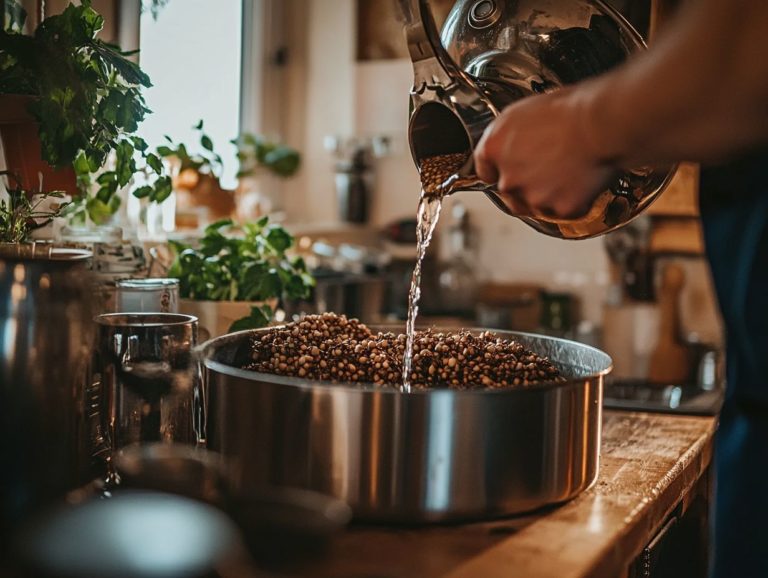Quick Tips for Efficient Home Brewing
Home brewing presents a remarkable fusion of creativity, science, and satisfaction. Whether you are a dedicated beer enthusiast or simply seeking an engaging new hobby, crafting your own beverages at home can be immensely fulfilling. The process is also time-saving and provides immense flexibility.
This guide will equip you with the essential tools required, outline the fundamental steps to embark on your brewing journey, highlight common pitfalls to sidestep, and provide invaluable tips for efficient brewing. You ll also find fermentation tips and cleaning tips to optimize your brew day.
Immerse yourself and uncover just how easy and enjoyable it can be to create your own exquisite brews, whether you are using grains, hops, or experimenting with different yeast strains!
Contents
- Key Takeaways:
- Why Should You Start Home Brewing?
- What Are the Essential Tools for Home Brewing?
- 1. Fermentation Vessel
- 2. Airlock and Bung
- 3. Hydrometer
- What Are the Basic Steps for Home Brewing?
- What Are Some Common Mistakes to Avoid in Home Brewing?
- What Are Some Tips for Efficient Home Brewing?
- Frequently Asked Questions
Key Takeaways:
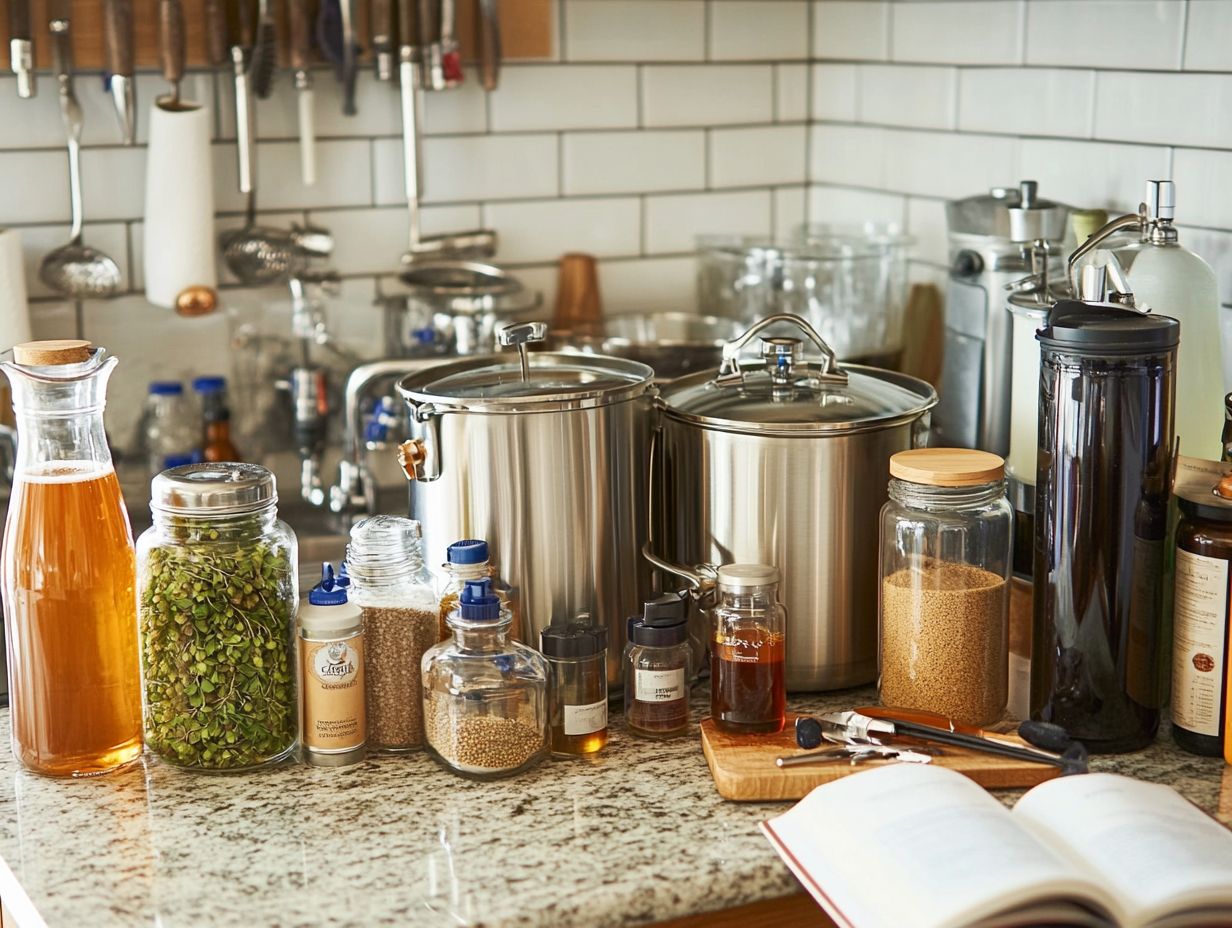
- Home brewing allows for cost-effective and customizable beer options.
- Essential tools for home brewing include a fermentation vessel, airlock and bung, hydrometer, siphon, and bottles with a bottle capper.
- Basic steps for home brewing include sanitation, boiling the wort, cooling the wort, fermentation, and bottling and carbonation.
Why Should You Start Home Brewing?
Home brewing can also be a party favorite, making social gatherings more enjoyable with your unique creations!
Home brewing stands as a truly rewarding hobby, granting you the opportunity to craft distinctive flavors and styles of beer while providing remarkable time savings and control over the brewing process. Moreover, by using brewing software, you can document brewing sessions and improve gradually.
By immersing yourself in the intricacies of brewing, you can elevate your brew day to new heights selecting high-quality ingredients such as grains, hops, yeast, and water, and applying fermentation strategies that promote yeast health and reduce oxidation.
This dedication culminates in a superior final product that reflects your efforts. Opting to keg instead of bottle not only streamlines carbonation methods but also ensures greater consistency in your homebrew experience, making each sip a testament to your craftsmanship. Additionally, kegging over bottling can save time and simplify the process.
What Are the Essential Tools for Home Brewing?
A variety of brewing equipment is necessary to ensure a successful brew.
Embarking on your home brewing journey requires assembling the right equipment, which is vital for ensuring a successful and efficient brewing process. Essential tools like a fermentation vessel are essential for the fermentation phase, while an airlock and bung work to prevent contamination and allow carbon dioxide to escape. Additionally, using a wort chiller can help rapidly cool your wort.
A hydrometer becomes your best friend for measuring specific gravity, and a siphon will help you transfer your beer without introducing unwanted oxidation. Moreover, having bottles and a bottle capper on hand prepares you for the final stages of kegging or bottling, solidifying your ability to savor your homebrew creations.
1. Fermentation Vessel
Proper organization on brew day can significantly improve your brewing experience.
A fermentation vessel is an essential component of your brewing toolkit. It serves as the home for your wort during fermentation. This is the stage where yeast works its magic, transforming sugars into alcohol while ensuring that yeast health remains optimal.
Fermenters come in various shapes and sizes to suit different brewing needs. You ll find a variety of fermentation vessels available, each boasting unique features that can significantly enhance your brewing adventure. Common choices include:
- Glass carboys
- Plastic buckets
- Stainless steel fermenters
Each type offers unique perks that can elevate your brewing adventure! Glass carboys, for example, won t absorb liquids and allow you to easily monitor the fermentation process. However, they can be cumbersome and are susceptible to breaking.
Plastic buckets are lightweight and budget-friendly. They may not be as effective at preventing oxidation, but they are convenient. On the other hand, stainless steel fermenters offer remarkable durability and excellent temperature control, albeit at a higher price point.
For a successful brew, keep your yeast in peak condition now every moment counts! Maintain appropriate temperatures and minimize oxygen exposure, as the latter can spoil your final product. Clean during downtime to ensure all equipment is ready for the next use.
2. Airlock and Bung
Trent Musho of Bru Sho often emphasizes the importance of using the right equipment.
An airlock and bung are essential tools in your brewing arsenal. They are designed to facilitate the escape of carbon dioxide generated during fermentation while keeping outside contaminants at bay. Kveik yeast, for example, can produce a lot of CO2 during fermentation.
By establishing a sealed environment, these components safeguard the integrity of your brewing process. This ensures that the flavors and aromas develop precisely as you intend. The airlock functions as a one-way valve, permitting gas to escape without allowing unwanted air to seep in, which could result in spoilage or undesirable off-flavors.
Bungs come in various designs, from rubber to silicone. Each provides different levels of airtightness and usability. Selecting the right combination of airlock and bung can profoundly impact your fermentation success.
This choice influences the rate of gas release while shielding your brew from oxidation and microbial infections. This careful selection ultimately leads to a cleaner, more flavorful final product that reflects your brewing craftsmanship.
3. Hydrometer
Schoolhouse Brewing provides excellent resources on using hydrometers effectively.
A hydrometer is an essential tool in your home brewing arsenal. It enables you to measure the specific gravity of your wort both before and after fermentation. Specific gravity (a measurement of density compared to water) reveals the alcohol content (ABV) and offers valuable insights into the fermentation process.
To harness the full potential of this device, take readings at the correct temperatures and ensure that no bubbles cling to the hydrometer. This ensures you achieve the most accurate results possible.
Once you’ve gathered your specific gravity measurements, integrating this data with brewing software like BeerSmith can significantly streamline your documentation process. You can also track IBU trends over time.
By entering these readings into the software, you can effortlessly track fermentation trends over time. This makes it easier to refine and optimize your recipes for future batches. This harmonious blend of traditional measuring techniques with cutting-edge technology enhances your overall brewing experience, allowing for adjustments that lead to improved flavors and greater consistency in your finished beer.
4. Siphon
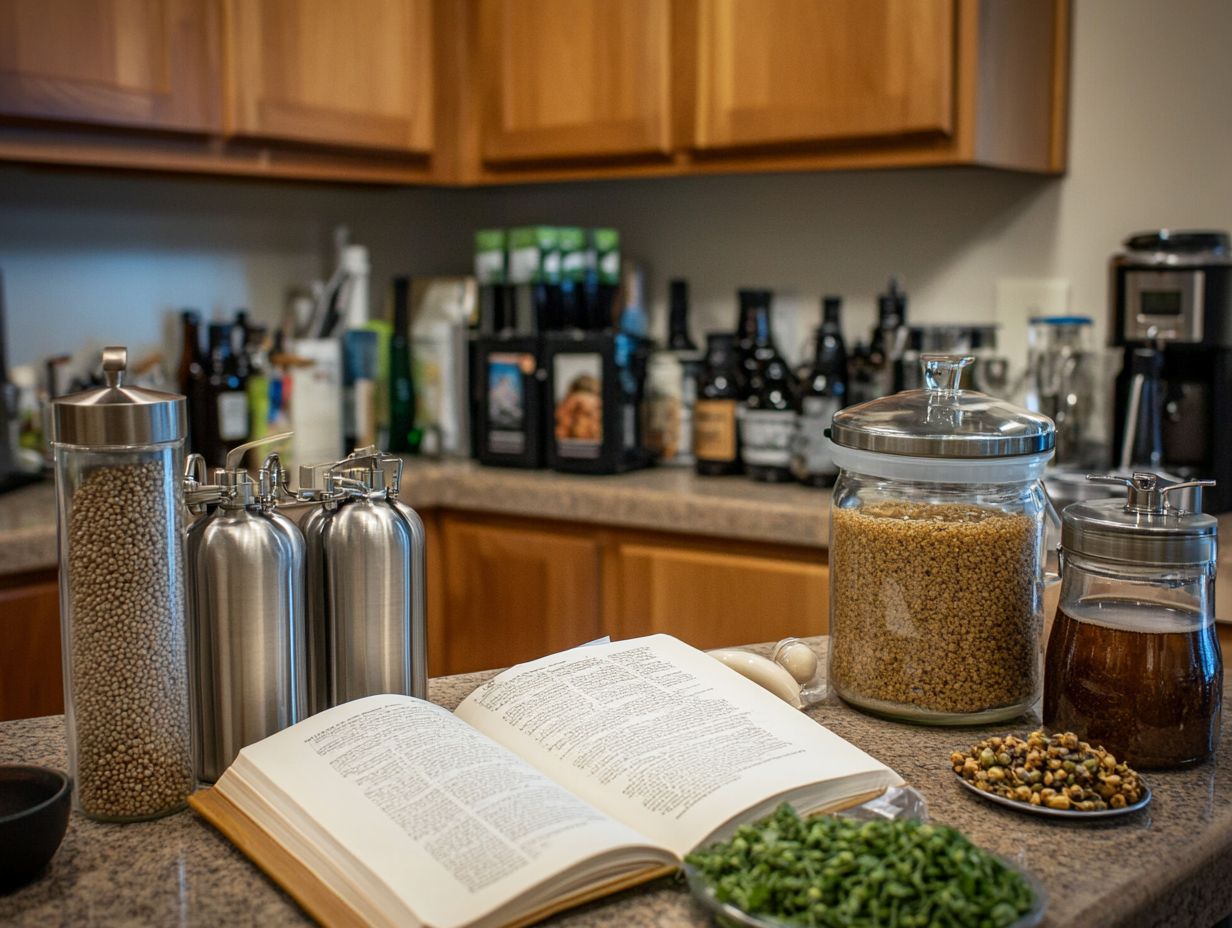
Trent Musho endorses various siphoning techniques to minimize oxidation.
A siphon is an essential tool for you when transferring your beer from one vessel to another. It allows you to minimize oxidation while ensuring a clean and efficient process. This is especially important during the fast brewing process to maintain beer quality.
Choosing the right type of siphon is crucial. Whether it s a straightforward tube or a more sophisticated auto-siphon, it can greatly impact the quality of your brew.
Many brewers prefer a specific siphoning technique that involves using a rubber or silicone hose to ensure a smooth transfer of liquid. Remember, keeping your equipment clean is vital for brewing success; any lingering contaminants can easily spoil your carefully crafted beer. Bru Sho often shares tips to ensure you achieve the best results.
This is why establishing a thorough cleaning routine during downtime is so important. By regularly sanitizing all of your equipment, you not only protect the integrity of your beer but also elevate your overall brewing experience.
5. Bottles and Bottle Capper
Short mash time techniques can also affect the final product’s quality.
Bottles and a bottle capper are essential tools for packaging your homebrew. They give you the option to choose between kegging and traditional bottling methods for carbonation. For those who prefer cider, the bottling process can also be applied effectively.
Using bottles grants you a level of flexibility that kegs simply can t match. This is especially true if you love sharing your creations at social gatherings or tastings. Bottling allows for individual servings, which is advantageous when you want to experiment with varying carbonation levels or flavor profiles across different bottles.
You ll find various types of bottles that cater to distinct beer styles. Darker beers thrive in amber glass, protecting them from light, while lighter ales can shine in clear bottles, showcasing their clarity. When you use a bottle capper, ensure that you achieve a tight seal to preserve carbonation and freshness.
Proper storage is key. Keeping your bottles upright and in a cool, dark place can significantly enhance the quality of your homebrewed beer, allowing it to age gracefully.
What Are the Basic Steps for Home Brewing?
Recipe simplicity can enhance your homebrewing success.
The essential steps for home brewing require a careful method, beginning with sanitization to ensure everything is clean and safe. For those looking to enhance their process, following 5 essential tips for clean brewing is a great start. Next, you’ll boil the wort, allowing the flavors to develop beautifully. Using a wort chiller can help cool it rapidly.
Once that s done, it’s crucial to cool it rapidly to preserve those delicate aromas. After cooling, fermentation takes place, an exciting phase where your brew begins to transform. During this phase, a yeast starter can help kick-start the fermentation process.
Finally, you ll bottle your creation, marking the culmination of your efforts. Each of these steps is vital for achieving a truly exceptional product. Properly documenting your process with brewing software can ensure repeatable results.
1. Sanitization
Effective sanitization is crucial for a successful brew day.
Sanitization stands as the cornerstone of home brewing, safeguarding your beer from spoilage bacteria and wild yeast. This ensures a triumphant fermentation process and enhances both yeast health and flavor quality.
This meticulous endeavor requires your full attention. Choose suitable cleaning agents, such as iodine-based sanitizers or no-rinse solutions, which proficiently eradicate potential contaminants.
It s vital that you thoroughly clean all equipment, including fermenters and bottles, to cultivate a sterile environment that fosters healthy yeast activity. These practices will help minimize oxidation and microbial infections.
By regularly integrating cleaning practices like employing hot water for initial rinsing or soaking your equipment for a designated period you ll keep everything impeccably spotless. A well-sanitized setup not only elevates the fermentation process but also enhances the overall vitality of the yeast, maximizing the flavors and carbonation of your final brew.
Schools like Schoolhouse Brewing offer workshops to hone these skills. Don’t wait! Start your brewing journey today with these essential tools and tips!
2. Boiling the Wort
Even fast brewing techniques require a thorough boil.
Boiling the wort is a crucial step in your home brewing journey. This process extracts the rich flavors and bitterness from the hops and sterilizes your mixture, creating a clean foundation for fermentation. Understanding the significance of oxidation minimization during this stage is essential to preserve the integrity of your brew.
During the boil, which typically spans 60 to 90 minutes, it’s important to maintain a temperature of around 212 F to achieve optimal extraction from the hops. The timing of your hop additions can significantly affect the final brew. Adding hops early in the boil contributes to bitterness, while later additions enhance the aroma. The quality of your ingredients matters immensely here fresh, high-quality hops will provide richer and more complex flavors.
By keeping your recipe straightforward and focusing on the timing of hop additions, you can create a balanced flavor profile that brilliantly showcases the unique characteristics of each ingredient.
3. Cooling the Wort with Trent Musho
Cooling the wort quickly after boiling is essential to prevent unwanted contamination and prepare the mixture for fermentation. You typically achieve this by using a wort chiller or an ice bath. Renowned brewers like Trent Musho from Bru Sho emphasize the importance of this step.
This rapid cooling process shields the wort from potential bacteria and enhances the overall health of the yeast, ensuring it can thrive during fermentation. When the temperature drops swiftly, it helps lock in flavors and clarity critical elements for crafting a high-quality brew.
Yeast functions best within specific temperature ranges. If you slow down the cooling process, you risk introducing unwanted off-flavors and stressing the yeast cells.
By employing effective cooling techniques, such as immersion chillers or counterflow systems, you ultimately support a more consistent fermentation process, which will reflect positively in the taste and aroma of your final product.
4. Fermentation
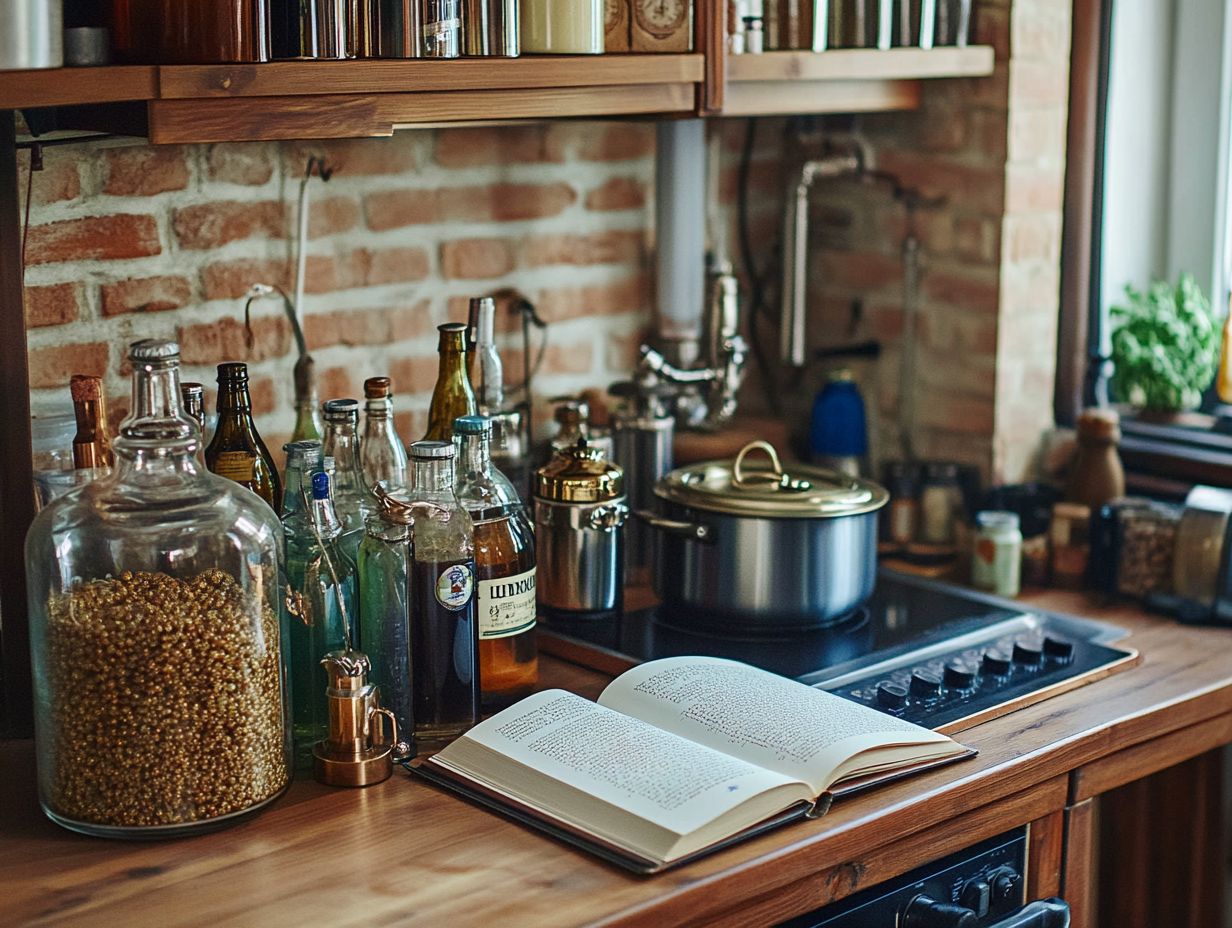
Fermentation is an exciting stage where yeast transforms sugars into alcohol and carbon dioxide. This process plays a significant role in determining the final alcohol by volume (ABV) and flavor profile of your brew. Some brewers prefer using Kveik yeast strains for their unique characteristics during fermentation.
To master this intricate art, pay close attention to temperature control. Yeast thrives within specific temperature ranges that can vary depending on the strain you choose. By maintaining an optimal temperature, you keep the yeast active and foster the development of desirable flavors while preventing unwanted byproducts.
To elevate yeast health further, it s essential to provide sufficient nutrients, monitor oxygen levels to reduce oxidation, and pitch the yeast at just the right moment. By grasping these fermentation nuances and implementing tailored techniques, you can create a cleaner, more complex flavor, leading to brewing a higher-quality beer.
5. Bottling and Carbonation
Bottling and carbonation represent the final flourish in your home brewing adventure as you transfer your carefully fermented beer into bottles or kegs. If you’re bottling, introducing priming sugar sugar added to beer before bottling to create carbonation is essential to achieve delightful natural carbonation.
This step shields your beer from contamination and elevates the flavors that developed during fermentation. When weighing your options between bottling and kegging, it s important to consider the distinct advantages and disadvantages of each.
- Kegging offers the convenience of easy dispensing and reuse.
- Bottling provides the benefit of portability, making it perfect for outings or sharing with friends.
Mastering proper carbonation techniques is crucial. Maintaining consistent temperatures during fermentation and utilizing CO2 canisters for your kegged beer can significantly impact the final taste and mouthfeel. Remember, cleanliness is non-negotiable for a quality product.
Thoroughly clean your bottles and caps with a reliable sanitizing solution to avoid any unwanted flavors or spoilage in your finished brew.
What Are Some Common Mistakes to Avoid in Home Brewing?
Common mistakes in home brewing can really derail your efforts, so it s crucial to identify pitfalls like improper sanitization, insufficient temperature control, and that all-too-human impatience during the brewing process.
Recognizing these issues can make all the difference in achieving the satisfying results you desire.
1. Not Sanitizing Properly
Failing to sanitize properly is one of the most critical mistakes you can make in home brewing, as it opens the door to contamination that can spoil the fermentation process and ultimately ruin your beer.
Such oversights not only compromise the quality and flavor of the final product but may also introduce unwanted bacteria or wild yeast, leading to unpredictable and often unpleasant brewing outcomes. Establishing a thorough sanitization routine is paramount for anyone serious about achieving consistent quality.
This means it s not just a matter of cleaning up once before brewing; it requires a vigilant practice that covers all equipment and surfaces that will come into contact with your precious brew.
By utilizing effective cleaning agents and mastering the right techniques, you can significantly enhance your brewing cleanliness, ensuring that every batch meets your high standards and delights the palate of every drinker.
2. Not Controlling Temperature
Failing to control the fermentation temperature can unleash off-flavors and compromise yeast health, paving the way for a brewing experience that could go horribly wrong.
Maintaining the right temperature during fermentation is vital, as yeast activity is incredibly sensitive to temperature shifts, which can significantly alter the taste and aroma of your finished product. For you as a brewer, this means paying close attention to the brewing environment to prevent fluctuations that could stress the yeast. Utilizing brewing software like BeerSmith can help you monitor and control these conditions effectively.
To tackle these variations effectively, consider implementing temperature control systems such as a fermentation chamber or insulated containers. Utilizing thermometers and temperature strips will also help you keep a vigilant eye on conditions.
This attention to detail can lead to a more consistent fermentation process, ultimately ensuring that the flavors in your final brew are well-developed and beautifully balanced.
3. Not Following Recipes
Ignoring recipes in home brewing can lead to inconsistent results, underscoring the importance of meticulously following guidelines to achieve those desired flavors and characteristics.
When you stray from tried-and-true methods, you often encounter unexpected consequences that can significantly alter not only the taste of your final product but also its texture and aroma. This inconsistency can be particularly vexing, especially when you’re aiming for a specific outcome. That’s why documenting each step and ingredient measurements and brewing times included is essential for anyone serious about perfecting their craft.
By embracing the simplicity of straightforward recipes, you can ensure consistency in your results, allowing you to fine-tune your techniques and recreate your favorite brews again and again.
4. Not Being Patient
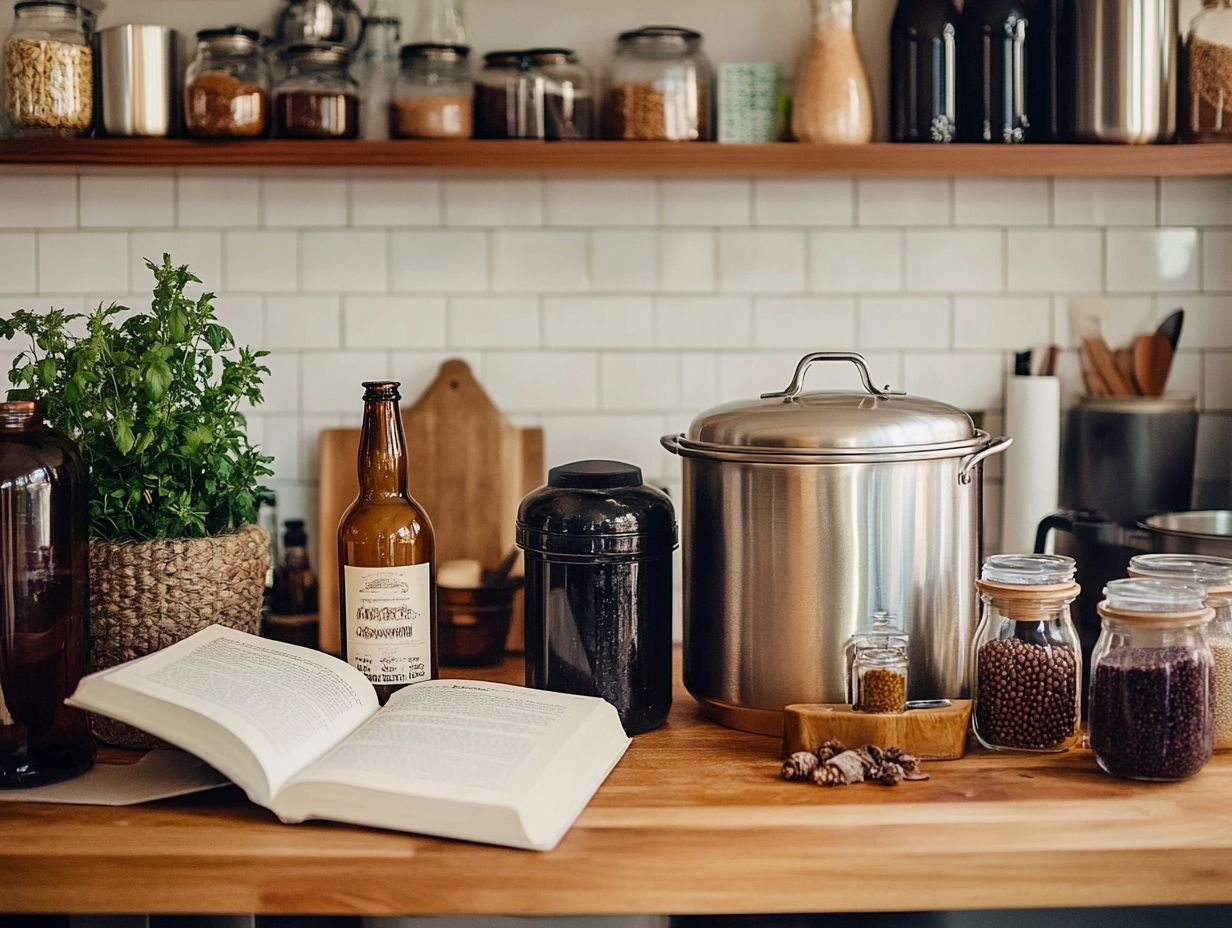
Rushing through the brewing process and lacking patience can seriously jeopardize the quality of your beer. Remember, fermentation and conditioning require ample time to fully develop those rich flavors you re after.
This period is essential, as the yeast needs sufficient time to feast on sugars and produce those delightful compounds that shape the beer’s character. Typically, fermentation can span from a few days to several weeks, depending on the style and recipe you ve chosen. During this time, your beer will gradually unveil its unique taste profile, with complexities blossoming with each passing day.
To manage your expectations, consider taking notes throughout your brewing journey. Observe how the flavors evolve at different stages. Embracing the idea that good things come to those who wait can transform your brewing experience into one filled with satisfaction and anticipation, ultimately leading you to a far superior final product.
What Are Some Tips for Efficient Home Brewing?
Home brewing can be a rewarding hobby. Here are some essential tips to enhance your brewing efficiency.
1. Keep Your Equipment Clean and Organized
Maintaining clean and organized brewing equipment is crucial for a seamless brewing process. By doing so, you significantly reduce the risk of contamination while ensuring that each brew day unfolds smoothly.
An organized workspace boosts your efficiency and reduces stress during brewing. Implement storage solutions like labeled bins and shelving for easy access to your ingredients and tools.
Furthermore, the importance of keeping your equipment clean cannot be overstated. Regularly cleaning your tools after each use prevents any residue buildup that could adversely affect the flavor and quality of your brew.
Make it a habit to use hot water and unscented soap for your cleaning routine, followed by thorough rinsing and sanitization to banish any potential pests or bacteria.
Embrace these practices for a brewing experience that will consistently wow your friends and family!
For additional guidance, you might look into resources from experts like Trent Musho and his Bru Sho channel.
2. Use Quality Ingredients
Using quality ingredients is essential in home brewing, as the grains, hops, yeast, and water you select have a direct influence on the flavor and overall success of your beer. Each component you choose plays a vital role in crafting a brew that not only delights your palate but also captures the essence of the brewing process.
For example, selecting the right type of malt can enhance sweetness or introduce delightful caramel notes, while the specific hops you choose will define the bitterness and aromatic qualities of your beer.
The yeast strain you opt for can affect fermentation speed and flavor profiles, resulting in unique outcomes even from the simplest recipes.
Don’t overlook water quality it significantly impacts flavor extraction from grains and hops. Understanding ABV (Alcohol By Volume) and IBU (International Bitterness Units) helps you fine-tune your brew.
By paying close attention to these details, you can create distinctive and enjoyable beers that truly reflect your personal taste.
3. Take Accurate Measurements with Brewing Software
Taking precise measurements during the brewing process is essential for achieving consistency and efficiency, ensuring that every batch aligns with your desired specifications. Using brewing software like BeerSmith can help you manage your brewing process more easily.
Utilizing accurate tools like calibrated scales and graduated cylinders can significantly improve the precision of your ingredient measurements.
Monitoring fermentation temperature and gravity with digital refractometers or hydrometers is crucial for evaluating your brew’s progress. By documenting each step whether through brewing logs or software you enable yourself to analyze your processes, replicate those successful batches, and make informed adjustments for your future brews.
4. Experiment with Different Flavors and Styles
Experimenting with different flavors and styles in home brewing opens the door to unique combinations. This allows you to tailor your beer to your specific taste preferences.
For a different twist, you could try fermenting with Kveik yeast, a traditional Norwegian yeast known for its unique flavor contributions and rapid fermentation.
Your journey as a home brewer goes beyond merely following traditional recipes. It s an opportunity to push boundaries and explore a diverse range of quality ingredients and brewing techniques.
By immersing yourself in the world of specialty grains, unique hops, and innovative fermentation methods, you can craft distinctive brews that showcase your personal flair. Schoolhouse Brewing is a great place to explore new ingredients and gain insights into advanced brewing techniques.
Incorporating fermentation tips can elevate your brewing adventure and guide you toward optimal taste and aroma. Whether you’re mixing unconventional flavor profiles or fine-tuning your boiling times, embracing your creativity can transform a simple batch into a craft masterpiece.
Frequently Asked Questions
What are some quick tips for efficient home brewing?
1. Use high-quality ingredients: Fresh and high-quality ingredients will greatly improve the taste of your home brew.
2. Keep your equipment clean: Sanitizing your equipment before and after each use will prevent contamination and ensure a better brew.
3. Plan ahead: Have all your ingredients and equipment ready before you start brewing to avoid any last-minute delays.
4. Use a thermometer: Temperature is crucial in brewing, so invest in a good thermometer to ensure your brew is at the right temperature throughout the process.
5. Take notes: Keep track of your brewing process, including ingredients, measurements, and timings, to replicate a successful brew in the future.
6. Practice patience: Good home brewing takes time, but it s worth the wait! Allow your brew to ferment and condition properly for the best results.
Now that you have these tips, why not start your brewing adventure today?

